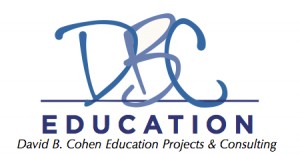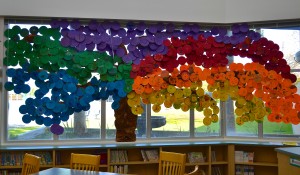This post originally appeared in my EdWeek Teacher blog, Road Trips in Education, on March 27, 2015.
I love libraries! I’m composing this blog post in a recently opened library in Palo Alto, and have always loved visiting libraries big and small, in schools and in some of the largest cities in the nation. And despite the competition from monuments and government buildings of great renown, The Library of Congress is my favorite site in Washington, D.C.
It’s not just the love of reading and books, but the nearly sacred atmosphere of libraries that draws me in. But these temples of knowledge and information are not sacred in the way of cathedrals – hushed whispers, pipe organs, candles and stained glass, prayer and genuflection. Though a library may offer sanctuary for someone seeking a quiet place to read or write, a good library still hums with life as people work at computer stations, wander the stacks and browse the periodicals, seeking vital information, new learning, or inspiration. The communal and civic purposes of libraries contribute to the quality of education in a school and the quality of life in a locality.

Merced High School librarian Sarah Morgan shows student work from an oral history project she helped support.
My year-long project visiting schools and teachers in California has been particularly enjoyable in the past few weeks as I’ve seen some wonderful libraries and dedicated librarians. Merced High School’s librarian, Sarah Morgan, embodies what a great school library and librarian can mean to the overall quality of student life and learning. I first encountered Sarah at a conference in San Jose, California. The Institute for Teaching (a branch of the California Teachers Association) organized an Innovation Exposition to present the excellent work that its grant program supports around the state. Sarah collaborated with history teachers at her school to create programs that engaged students in multiple projects relating to the history of their city and its people; the resulting student work was presented in a city museum and garnered the praise of historians at the University of California at Merced.
In my day at Merced High School, I observed how Sarah carries out the mission of a librarian to function as a teacher of every student in the school, and a key support to the teachers as well. The librarian role also requires constant learning and sharing about resources – educational resources, community resources, and fiscal resources – that are essential to school and student success. Through Sarah, I was able to see some excellent student work for the projects described above, and also better understand her collaboration with teachers. And at the end of the school day, she was still welcoming students into the library, along with college students who were there to do some after-school tutoring.
The school library was also a hub of activity and learning at the elementary school I visited the next day; my host was music teacher Genein Letford, and her school is NEW Academy, in Canoga Park, California. It’s always a good sign when I visit a teacher and find that individual is eager to steer me to see other colleagues and programs, and I ended up visiting NEW Academy library more than once. Librarian Kelly Spector has made the library into a vibrant and thoroughly welcoming space; her students not only have ample opportunities to find great reading material, but also to build an enthusiasm for reading through author visits and video conferencing via Skype. Genein and Kelly have also collaborated to invite students to react to their reading through other forms of artistic expression.
This week, I spent a morning with Kay Hones, a National Board Certified Teacher librarian in San Francisco Unified School District. Kay divides her time among multiple alternative high schools in the district. When I observed her at Downtown High School, she was supporting teachers and students in a project-based, interdisciplinary research project. At another school, all of her students are either pregnant or young mothers, and so the library functions differently to meet the unique needs of these students. In addition to serving the students at these alternative schools, Kay extends her work into advocacy for students and libraries by joining various district and city committees.
Unfortunately, too many people consider libraries as mere rooms full of books and computers, and librarians as mere functionaries in charge of the rooms and their contents. When district leaders look for savings in a budget, too often they see the most important teacher in a school as the most expendable. California schools have seen a marked decrease in the number of teacher librariansin recent years. New York City has about 50% more schools than it did in 2002, but more than half of the district’s libraries have closed in the past decade. In California, New York, and anywhere else cutting libraries, it’s a classic example of a penny-wise, pound-foolish approach to budgeting: there’s no shortage of evidence that libraries and librarians – both, together – have a strongly positive impact on student learning.
If you know anyone who still imagines a librarian is a glorified book clerk whose main interaction with patrons is sshhhh!, I urge you to have them visit a library and talk to a librarian about their work. The rise of the internet and the search engine and digital media has not rendered librarians any less essential; their expertise and dedication are needed more than ever, and those of us who value them must step up our advocacy in light of short-sighted library policy and budgeting.

